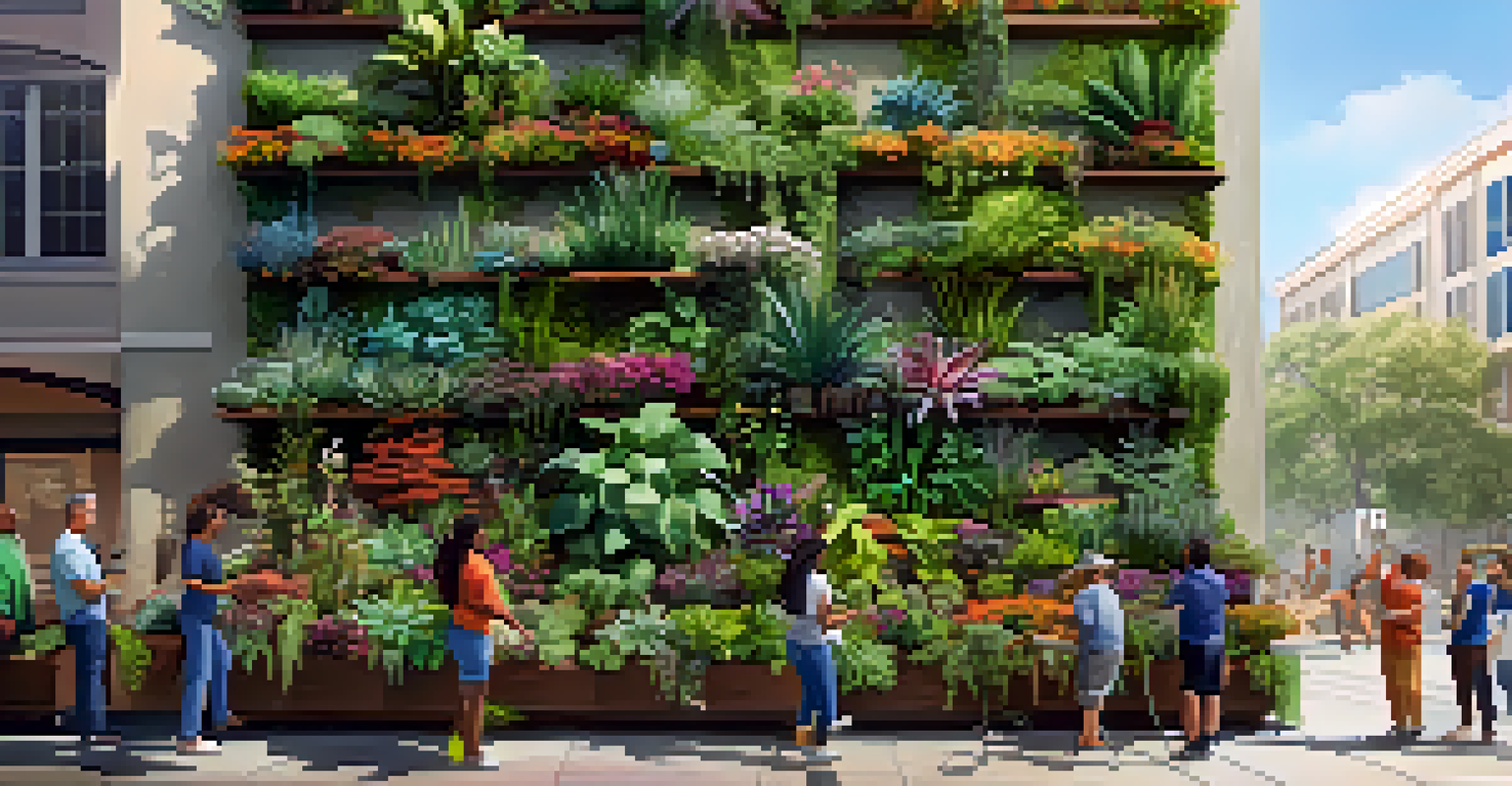Vertical Gardens: Transforming Urban Spaces with Plants

What Are Vertical Gardens and Why Do They Matter?
Vertical gardens, also known as green walls, are innovative structures that allow plants to grow vertically, often on buildings or fences. These gardens not only beautify urban environments but also contribute significantly to sustainability. By integrating greenery into our concrete jungles, they help combat pollution and improve air quality.
The best time to plant a tree was twenty years ago. The second best time is now.
Imagine living in a city where every blank wall is alive with color and life. Vertical gardens make this possible by utilizing space that would otherwise go unused. They provide a refreshing burst of nature in bustling urban areas, creating a calming oasis for residents and visitors alike.
Moreover, vertical gardens can play a vital role in temperature regulation. They absorb heat, thereby cooling buildings and reducing energy consumption. As urbanization continues to rise, the importance of these green spaces becomes even more pronounced.
Benefits of Vertical Gardens for Urban Living
The advantages of vertical gardens extend beyond aesthetics. They contribute to biodiversity by providing habitats for birds, insects, and other wildlife. This encourages a healthier ecosystem in urban areas, which can often feel devoid of nature.

In addition to environmental benefits, vertical gardens can enhance mental well-being. Research shows that exposure to greenery can reduce stress and promote a sense of calm. Imagine taking a stroll past a vibrant wall of plants after a hectic day; it’s a natural mood booster.
Vertical Gardens Enhance Urban Life
These green walls not only beautify cities but also improve air quality and provide cooling effects.
Lastly, vertical gardens can improve building insulation. The plants act as a natural barrier, keeping interiors cooler in summer and warmer in winter. This not only enhances comfort but can also lead to significant energy savings.
Designing a Vertical Garden: Key Considerations
Creating a vertical garden involves several key considerations, starting with plant selection. Choosing the right species is crucial, as they need to thrive in the specific light and climate conditions of your space. For example, succulents are perfect for sunny spots, while ferns thrive in shaded areas.
Nature does not hurry, yet everything is accomplished.
Another important factor is the structural support for your garden. It’s essential to ensure that the wall or framework can handle the weight of the plants and soil. A well-designed irrigation system is also vital to keep the plants hydrated without over-saturating the wall.
Lastly, maintenance is a key aspect of vertical garden design. Regular care, such as pruning and watering, ensures that the garden remains healthy and attractive. A little effort can go a long way in keeping your green wall vibrant and flourishing.
Vertical Gardens: A Sustainable Solution
Vertical gardens significantly contribute to sustainability efforts in urban environments. They promote the use of native plants, which require less water and maintenance, thus reducing environmental impact. This can be particularly beneficial in areas facing water scarcity.
Additionally, these gardens can help in managing stormwater runoff. By absorbing rainwater, they reduce the burden on drainage systems and minimize flooding risks. This natural solution is a compelling argument for incorporating green infrastructure into city planning.
Sustainable Benefits of Green Walls
Vertical gardens reduce water usage, manage stormwater, and promote biodiversity, making them vital for sustainability.
Moreover, vertical gardens can also serve as community projects, engaging residents in sustainability efforts. By coming together to create and maintain these green spaces, communities foster a sense of belonging and responsibility towards their environment.
The Role of Vertical Gardens in Climate Change Mitigation
As climate change becomes an increasingly pressing concern, vertical gardens offer a practical way to mitigate its effects. They can help reduce the urban heat island effect, where city temperatures are significantly higher than surrounding areas due to human activities and infrastructure.
By incorporating more greenery into urban spaces, we can lower temperatures and improve air quality, making cities more livable. Vertical gardens absorb carbon dioxide and release oxygen, contributing to a healthier atmosphere.
Furthermore, they can serve as a platform for public education on climate action. Workshops and community events centered around vertical gardening can raise awareness and encourage sustainable practices among urban dwellers.
Inspiring Examples of Vertical Gardens Around the World
Cities worldwide are embracing vertical gardens, showcasing the transformative power of plants. One remarkable example is the Bosco Verticale in Milan, Italy, where two residential towers are adorned with over 9,000 trees, creating a stunning green facade.
In Paris, the Musee du Quai Branly features a spectacular vertical garden designed by renowned botanist Patrick Blanc. This living artwork not only beautifies the museum but also helps to regulate temperature and promote biodiversity in the city.
Community Engagement through Gardening
Creating vertical gardens fosters community involvement and education, encouraging shared responsibility for the environment.
These examples illustrate how vertical gardens can redefine urban landscapes, turning ordinary buildings into extraordinary living spaces. They inspire cities everywhere to rethink the way we integrate nature into our daily lives.
How to Get Started with Your Own Vertical Garden
Starting your own vertical garden can be a rewarding project, and it doesn’t have to be complicated. Begin by selecting a suitable location, ideally one that receives adequate sunlight and is easily accessible for maintenance. You might want to consider a small wall or even a balcony to get started.
Next, choose your plants based on the conditions of your space. Remember to mix in different species to create a vibrant and diverse garden. Whether you opt for herbs, flowers, or succulents, select plants that will thrive together and complement each other’s growth.

Finally, invest in a good irrigation system or watering method to keep your plants healthy. With a little creativity and care, you can create a stunning vertical garden that not only beautifies your home but also contributes to the environment.